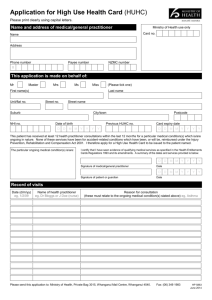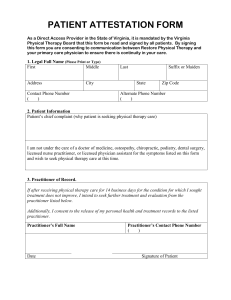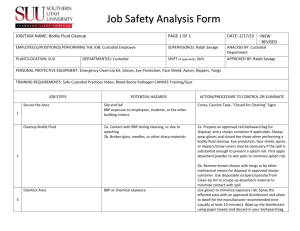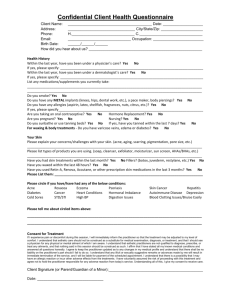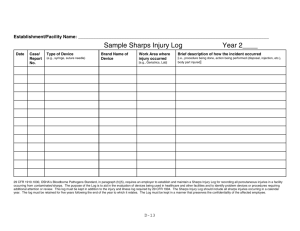california's safe body art act of 2011 (ab 300)
advertisement
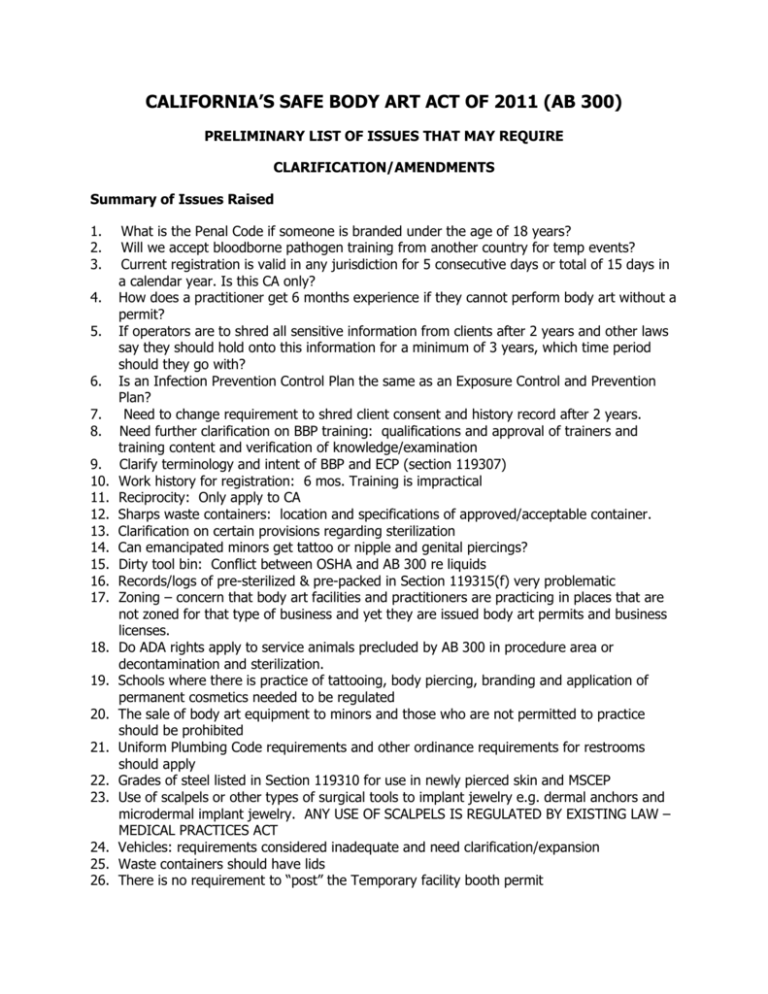
CALIFORNIA’S SAFE BODY ART ACT OF 2011 (AB 300) PRELIMINARY LIST OF ISSUES THAT MAY REQUIRE CLARIFICATION/AMENDMENTS Summary of Issues Raised 1. 2. 3. 4. 5. 6. 7. 8. 9. 10. 11. 12. 13. 14. 15. 16. 17. 18. 19. 20. 21. 22. 23. 24. 25. 26. What is the Penal Code if someone is branded under the age of 18 years? Will we accept bloodborne pathogen training from another country for temp events? Current registration is valid in any jurisdiction for 5 consecutive days or total of 15 days in a calendar year. Is this CA only? How does a practitioner get 6 months experience if they cannot perform body art without a permit? If operators are to shred all sensitive information from clients after 2 years and other laws say they should hold onto this information for a minimum of 3 years, which time period should they go with? Is an Infection Prevention Control Plan the same as an Exposure Control and Prevention Plan? Need to change requirement to shred client consent and history record after 2 years. Need further clarification on BBP training: qualifications and approval of trainers and training content and verification of knowledge/examination Clarify terminology and intent of BBP and ECP (section 119307) Work history for registration: 6 mos. Training is impractical Reciprocity: Only apply to CA Sharps waste containers: location and specifications of approved/acceptable container. Clarification on certain provisions regarding sterilization Can emancipated minors get tattoo or nipple and genital piercings? Dirty tool bin: Conflict between OSHA and AB 300 re liquids Records/logs of pre-sterilized & pre-packed in Section 119315(f) very problematic Zoning – concern that body art facilities and practitioners are practicing in places that are not zoned for that type of business and yet they are issued body art permits and business licenses. Do ADA rights apply to service animals precluded by AB 300 in procedure area or decontamination and sterilization. Schools where there is practice of tattooing, body piercing, branding and application of permanent cosmetics needed to be regulated The sale of body art equipment to minors and those who are not permitted to practice should be prohibited Uniform Plumbing Code requirements and other ordinance requirements for restrooms should apply Grades of steel listed in Section 119310 for use in newly pierced skin and MSCEP Use of scalpels or other types of surgical tools to implant jewelry e.g. dermal anchors and microdermal implant jewelry. ANY USE OF SCALPELS IS REGULATED BY EXISTING LAW – MEDICAL PRACTICES ACT Vehicles: requirements considered inadequate and need clarification/expansion Waste containers should have lids There is no requirement to “post” the Temporary facility booth permit 27. 28. 29. 30. 31 32. 33. 34. 35. Handwashing – concern about allowing sanitizer as a substitute for handwashing Ultrasonic cleaners: Need ultrasonic cleaner cover guidelines Equipment certification? Contaminated sharps waste vs non-sharps waste could be better defined Require apron, bib, or lap pad in Section 11308(a)(2) – concern that it should be disposable if needed and depends on the type of body art procedure (tattoo, body piercing, branding and permanent cosmetics). There is no requirement that all surfaces, including but not limited to, counters, cabinets, tables, equipment, chairs, recliners, shelving, and cabinets in the service area and cleaning room are made of smooth, non-absorbent materials that can be easily cleaned and disinfected and in good repair Temporary Booth Facility Requirements needs limitations: Number of practitioners in a booth to prevent overcrowding and Size (dimensions) of the booth Holding the event sponsor responsible and accountable for violations and imminent health hazards e.g. sharps waste disposal in the parking lot. Why is there is nothing being done to regulate extreme body modifications? Additions from Heather Stachelrodt: 36. Some mention about schools of body art should be included. It is critical that we clarify weather schools who allows practice of body art on the public by students should be included. Specifically, are they to be regulated like all other body art facilities or are they to be granted some sort of exclusion? 37. Update section 119310(b): Grades of steel acceptable in a new piercing should be written in a way to include new acceptable metals as they become available to industry. Steve Joyner mentioned that many of metals listed in AB300 are already out of date. Also we should add that there should be a “mills certificate” for all jewelry used in a new piercing on site and available upon inspection. I believe this is one of the only documents that will describe the grade of metal being used (according to Steve Joyner & Paul Stoll). 38. 119316(a), 119314(a) Mobile body art vehicles section: I believe the law should be changed/updated so that they come under the section of a permanent facilities only – not under temporary event guidelines. Deciding which portion of the law is enforceable based on the amount of time they will be doing business is unclear. Also the guidelines for temporary facilities is not a good fit for mobile facilities for a number of reasons. 39. There are limited requirements for the plan check section of the law. At minimum a statement requiring that “all surfaces, including but not limited to, counters, cabinets, tables, equipment, chairs, recliners, shelving, and cabinets in the service area and cleaning room are made of smooth, non-absorbent materials that can be easily cleaned and disinfected and in good repair” should be added to the law. 40. We should add more responsibility to an event sponsor such as issues already mentioned, “violations and imminent health hazards e.g. sharps waste disposal in the parking lot” but also ensuring that the public maintain fresh work bandaged during the event – not ever be allowed to walk around the event with fresh, uncovered work unless they are on the stage/separate area as part of a competition and only during that time period. I believe these issues are important in protecting the public. 41. Apparently galvanized steel is the only kind of steel that can be used in branding. I do not know if we should add this level of information to the actual law but I thought it was important enough to at least mention to you all. 42. 119307(b), There seems to be a lot of confusion around this section. It basically describes anyone working in or around the body arts facility including all contractors, employees and volunteers who perform duties within the decon or procedure areas - shall be provided BBP training by the owner. Therefore shop assistants or apprentices who may not be performing body arts still must obtain BBP training! This makes sense but some folks read it as only pertaining to body arts technicians. Do we need clarification on this? 43. 119315 (3), we may want to make the type of testing (use of integrator) a little more open ended to allow for new, improved methods that may hit the market. It does say “at a minimum” but I do not know if wording creates enough flexibility. 44. 119315, I am concerned about there being no specific mention of the types of autoclaves that are acceptable or unacceptable. It was mentioned at the last training that chemical autoclaves were not allowed due to them causing a gluteraldehyde coating on equipement and jewelry. Also there has been concern that the “statim” machines should be allowed but according to the law, they would not be. I do not see any restrictions or specific information on the types of autoclaves. Should we add language to restrict and allow various types – if it is already there please let me know. 45. 119314(c-1), I propose that we add language to make the decon room a physically separate room with floor to ceiling walls and a closeable door. This is for a number of reasons but he main reason is to ensure the public cannot enter this area or end up touching something in here. 46. Question: Should Housing and Community Development of DOT be involved in the permitting of mobile vehicles? Special licensing or anything of that nature? 47. Question: 119304, If a permanent cosmetics practitioner is working in a Medical Spa or in a doctor’s office do they still need a health permit with the LEA? The law does not restrict activities of physicians or surgeons but what about the PC Practitioners that work under them? I am sure this will be a question that will come in each jurisdiction at some point so we should consider the answer – for all statewide. This may require some clarification in the law. 48. 119318(b-6) The law calls for an emergency eye wash station at the temporary events but not for the permanent facilities. Was this an oversight? Do we want to add it for the permanent facilities or possibly remove it for the temp events? DETAILS ON CERTAIN ISSUE RAISED 1. Client consent and history record a. Shred after 2 years – (see attachment from concerned practitioner) There is concern that shredding medical history of client who may return many years later for body art may have a health condition e.g. diabetes or heart disease which may be a potential health risk for the client and put the practitioner in a liable situation. The practitioner needs to keep baseline medical information and the ability to make informed decisions with the client. i. Not reasonable as currently written ii. Needs follow-up legislation b. HIPAA – There is concern that this does not apply to body art practitioners and facilities since the practice is not related to the medical field or for health insurance purposes. 2. BBP Training a. Trainers i. Approval process ii. Qualifications 3. 4. 5. 6. b. Training i. Classroom and/or web-based – concern about certain jurisdictions not allowing web-based training because of the ability to monitor the validity of those taking web-based training. However, it would be problematic if web-based training was not accepted. Also, there is the issue of reciprocity. ii. 2-hour requirement for training? “Bloodborne Pathogen Exposure Control Plan Training” (See AB 300 Section 119307) – BBP and ECP are two distinct trainings. A BBP training course may have elements of the ECP but it is offered in general terms. The ECP (AKA: IPCP) is a plan that is specific to each facility where the practitioner is working and so the training involves reading and understanding the IPCP for the specific facility. a. Clarify the terminology and intent – use of “Exposure Control Plan” and “Infection Prevention Control Plan.” These terms are essentially the same thing. The intent is to require a practitioner to obtain 1) BBP training and 2) training on the facility’s “Infection Prevention Control Plan.” Section 119313(d) covers the onsite training on the facility’s IPCP. Practitioner Registration Requirements a. Work history (see attachment from concerned practitioner) – There is concern about the 6 months prior experience and lack of defined criteria. Very problematic. i. Either take out the requirement all together or develop specific criteria based on industry standards (each field - tattoo, body piercing, permanent cosmetics and branding - may have different criteria) ii. Establish criteria for the trainers b. Apprentice – BBP yes; practitioner registration? c. Employees that have access to sterilization area but are not practicing body art– (Resolved: BBP yes; practitioner registration no) d. 5 consecutive days/15 day total in a year for practitioner reciprocity – why? Clarification? e. Can emancipated minors obtain a practitioner registration? Sharps Waste Container a. Located in clean room – concern that dirty sharps waste should not be stored where clean and sterilized instruments are stored b. Commercial sharps container – there is no referral to the type of approved container (rigid, puncture proof, leak proof, etc.) Sterilization a. “Steam” sterilizer – whether AB 300 specifies that the sterilizer must be “steam”. Also, does AB 300 allow for other types of sterilization and/or equipment e.g. statim, chemical, soaking in gluteraldehyde b. Statim – describe sterilization method since “peel-packs” are not used in this process c. In section 119315(b)(3), does the “mechanical indicator” mean gauges? The Class V Integrator should be the indicator for each load. Also, it is misleading that each individual sterilization pack must have a Class V integrator. The intent that each individual sterilization pack has a color change indicator (which is not the same as a Class V integrator). d. Is there a requirement for sterilization equipment to have gauges? 7. Client a. Food and beverage - Resolved: Section 119309(i) b. Emancipated minors – can emancipated minors get tattoo or nipple and genital piercings? 8. Dirty tool bin a. OSHA says “no liquid” (Note: OSHA allows liquid in used equipment container if it has a cover that latches and seals the container) b. AB300 says “liquid” 9. Pre-sterilized & pre-packed in Section 119315(f) a. Records and Logs: very problematic i. Not reasonable as currently written ii. Needs follow-up legislation 10. Facilities a. Zoning – concern that body art facilities and practitioners are practicing in places that are not zoned for that type of business and yet they are issued body art permits and business licenses. 11. Service animals in procedure areas – concern that AB 300 states that no animals are allowed in procedure area or decontamination and sterilization. Do ADA rights apply? 12. Schools where there is practice of tattooing, body piercing, branding and application of permanent cosmetics needed to be regulated a. Very problematic b. Students and teachers should be required to have BBP training 13. The sale of body art equipment to minors and those who are not permitted to practice should be prohibited 14. Restroom requirements in a permanent body art facility. Adequate toilet facilities which is in accordance with Uniform Plumbing Code and any other local ordinances. This includes toilet paper. A handsink located in the restroom and supplied with soap in a wall mounted dispenser and single use paper towels or other approved hand drying device. 15. Grades of steel listed in Section 119310 for use in newly pierced skin and MSCEP 16. Use of scalpels or other types of surgical tools to implant jewelry e.g. dermal anchors and microdermal implant jewelry. a. The use of surgical tools b. The practice of dermal anchors and microdermal implants 17. Vehicles: very problematic a. AB 300 only refers to meeting requirements in Section 119317 (b) to (g). Are there no other requirements for a vehicle, especially permanently permitted one, to adhere to e.g. toilet facilities, separate decon/sterilization area, separate waiting area, carpeting and other finish materials, plan check, electrical, plumbing, hot water, water source and wastewater disposal, sharps waste disposal, ventilation, occupancy standards (state mobile vehicle requirements and DOT), location, zoning, IPCP, etc? 18. Waste containers should have lids 19. There is no requirement to “post” the Temporary facility booth permit 20. Handwashing – concern about allowing sanitizer as a substitute for handwashing 21. Ultrasonic cleaners a. Needs ultrasonic cleaner cover guidelines b. Require that it is cleaned and maintained according to manufacturer’s specifications c. Require a label, “biohazardous” and placed away from the sterilizer and workstations 22. Equipment certification? 23. Do us all a favor, ban “piercing guns” 24. Contaminated sharps waste vs non-sharps waste could be better defined a. Disposing of contaminated non-sharps waste in regular solid waste brought confusion and needs to be clarified. Contaminated non-sharps waste must not be disposed in sharps waste container or red bag biohazardous waste. 25. Require apron, bib, or lap pad in Section 11308(a)(2) – concern that it should be disposable if needed and depends on the type of body art procedure (tattoo, body piercing, branding and permanent cosmetics). 26. There is no requirement that all surfaces, including but not limited to, counters, cabinets, tables, equipment, chairs, recliners, shelving, and cabinets in the service area and cleaning room are: a. made of smooth, non-absorbent materials that can be easily cleaned and disinfected b. in good repair 27. Temporary Booth Facility Requirements a. Needs booth limitations i. Number of practitioners in a booth to prevent overcrowding ii. Size (dimensions) of the booth 28. Holding the event sponsor responsible and accountable for violations and imminent health hazards e.g. sharps waste disposal in the parking lot 29. Why is there is nothing being done to regulate extreme body modifications? Additional comments: 1. The body art facility shall shred any confidential medical information after two years from performing thebody art procedure on the client. I feel strongly that practitioners should be in control of when client records are no longer needed. In the permanent cosmetic industry the procedures we conduct require “maintenance” on a periodic basis. We refer to these records during conversations with our clients to ensure medical related condition(s) (if any) that were indicated on our initial records for that client are addressed again before going forward with touch up procedures. Also, as I have mentioned before, practioners should be able to keep any particular records necessary to support insurance company requirements as proof of the client’s profile at the time of the service. In an attempt to work with the desire for old records to be discarded, possibly the wording could be changed to the following: “The body art facility shall shred any confidential medical information when it has been deemed those records are no long required to support the practitioner/client relationship. Client records shall be stored in a manner that ensures confidentiality of information. “ 2. For first-time registrants, documentation evidencing a minimum of six months of related experience. I believe there has been adequate discussion to support that this vague statement in AB300 sufficiently defined to work for consistency of interpretation and application. Initially I will give an example of why this is not an adequate reference to training in one state (to limit the conversation on this issue) which is Tennessee. Their law requires a one year apprenticeship for body art. No further support or stated requirements of what that one year apprenticeship included as far as subject matters address or technical training , just that “a one year apprenticeship.” What resulted from this is prospective practitioners in training were able to call upon anyone who already had a license for training – regardless of credentials. Because of the lack of stated legal requirements that spoke to the required credentials for a person to legally be considered a “trainer” and the lack of stated program curriculum, this clearly did not produce the intended results. What resulted was that people who had possibly only been offering services themselves for a short period of time offering training services. Training was not required to be structured due to the lack of a stated curriculum in the law. In one example a person paid 10k to “be with” another practitioner during a year’s period of time. A class completion certificate was given to this person, she obtained her Tennessee license and then because ethically she knew she did not have the skills necessary, she went out of state for appropriate training. Establishing training requirements and enforcement of standards of practice for any industry is an important and time consuming endeavor. I am glad to be part of that endeavor but cannot condone, for obvious reasons, a blanket “one year apprenticeship, or six months related experience” concept. As an example of guidelines that are consistent and stated for enforcement, the following are excerpts from the current Society of Permanent Cosmetic Professionals (SPCP) minimum criteria for a fundamental class for permanent cosmetics. I’ll provide excerpts to make my points but the full version can be read by going to the SPCP website at www.spcp.org and all of the requirements if they wish. Trainer Credentials excerpts as examples: I. BUSINESS SET-UP Business shall be in compliance with all state educational statues, zoning regulations and health ordinances. II. PROFESSIONAL BACKGROUND Each trainer will have a minimum of five (5) years experience in the application of permanent cosmetic procedures and have completed a minimum of three hundred (300) procedures for each procedure type that is taught and must be verifiable. Trainers will complete not less than sixteen (16) hours of continuing education over a two (2) year period. This may include attendance at conventions and other classes pertinent to the permanent cosmetics field. Fundamental class curriculum excerpts as examples: I. Introduction to Permanent Cosmetics A. History of tattooing as it applies to permanent cosmetics (optional) B. Overview of the different types of machines and devices available II. Consultation A. Client profile 1. Analyze character of client and client selection 2. Client expectations 3. Discuss overall aspects of permanent cosmetics B. Client history/client information form 1. Identify potential problems for permanent cosmetics 2. Determine when physician review is advised C. Consent forms 1. Discuss informed consent 2. Liability issues III. Office set-up A. Physical setting 1. General Equipment a. table, chair, work surface, lighting B. Building codes IV. Disinfection and Sterilization A. Equipment 1. Discuss acceptable forms of sterilization 2. Disinfectants and antiseptics B. OSHA and CDC guidelines regarding bloodborne pathogens C. Technician safety 1. Hand washing 2. Hepatitis B vaccination 3. Gloves D. Proper handling of devices, needles, and pigments E. Sanitary measures during procedure set-up F. Sanitary measures during procedure clean-up V. Client preparation A. Pre-procedure care 1. Preparing the client’s skin 2. Ways of marking the skin B. Anesthetics and physician relationships VI. Color and pigment theory A. Knowledge and use B. Pigments 1. Preparation, mixing 2. Storage VII. Skin anatomy A. Composition/layers B. Healing process of skin and its care C. Diseases, disorders and conditions 1. Infection 2. Herpes 3. Moles, warts, freckles 4. Psoriasis, eczema 5. Reactions VIII. Machine theory A. Review machine (device) for technical aspects 1. Operation and maintenance 2. Use: speed, pressure, angle 3. Trouble-shooting B. Evaluate capabilities of devices C. Only one type of device will be taught at the fundamental level once a preferred method is established IX. Needles A. Appropriate needle selection and applications 1. Groups, numbers and configurations B. How mechanically used in the skin C. Maintenance 1. Check for damage 2. Storage and disposal 3. Preparation for sterilization if not pre-sterile when purchased X. Photography A. Rationale B. Equipment and methods 1. Clarity 2. Presentation XI. After Care A. Client follow-up B. Forms and instructions to provide XII. Procedure experience: two (2) of each complete procedures: eyebrows, eyeliner, (optional at fundamental level – lip liner, shaded lip liner, beauty marks) A. Review issues, discuss 1. Facial morphology 2. Variations B. Work on pigskin or similar practice medium C. Observe procedures D. Hands-on live model work XIII. Business set-up A. Basic business and marketing guidelines (optional) B. Legal requirements C. Insurance/liability End of excerpt examples My own personal training curriculum (19 pages) represents compliance with these guidelines on an hour-to-hour basis. My point hopefully is obvious. A blanket “six months of related experience, or one year apprenticeship” or any variation thereof is inadequate to produce an intended legal requirement for a person to “qualify” as a body art practitioner. My suggested options at this time are as follows: In any event, the current “six months related experience” should be omitted from AB300 due to lack of definition. If the Health Department desires to address training, separate legislation should be enacted after the trainer credentials and training provisions have been agreed to. Based on my experience in Washington, there is not a “one training program fits all” solution considering the different services offered within the body art industry. The Department of Licensing (DOL) has attempted to establish training requirements under this concept for over two years. One group doesn’t feel they need elements another group does and so it goes. Because of this, I feel ultimately they may consider separate training groups and programs, time will tell. If the Health Department does decide to address trainer credentials and training guidelines, a separate team of professional practioners, those who would be considered qualified to be a trainer under new guidelines, should work with team appointed regulators to determine the appropriate trainer/training guidelines to include in new legislation for: Traditional tattoo body art; Piercing body art; Branding body art; Permanent Cosmetic body art It is only when like practitioners, offering the same services convene and discuss training credentials for a trainer and an appropriate training curriculum for their specific services will there be agreements on the table. 3. My last concern, and this is supported by being advised recently that Sears is offering tattoo supplies, is that AB300 does not require companies who operate in California to only sell supplies to people who are eighteen years of age and who have a legitimate business license. I’ve not thought this particular problem out thoroughly, but want to put it out there for discussion.


